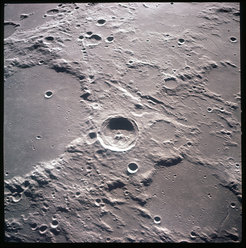Tiny Meteorites Create Lunar Atmosphere
To understand the processes that create the moon’s thin atmosphere, researchers have examined lunar samples from the Apollo missions.
The extremely thin atmosphere that surrounds the moon is primarily created by the constant bombardment of the lunar surface by dust-sized mini-meteorites. Other processes, such as the interaction with particles and radiation from the Sun, play a subordinate role, as researchers from the University of Chicago, the Massachusetts Institute of Technology, the Max Planck Institute for Solar System Research (MPS) and the NASA Goddard Space Flight Center report today in the journal Science Advances. The team examined soil samples that astronauts from the Apollo missions brought back to Earth decades ago. This material was in constant exchange with the moon's atmosphere for billions of years - and thus witnessed the processes that create and maintain its atmosphere.

Actually, the moon has no atmosphere at all - at least not by earthly standards. The less than ten tons of material that make up its gaseous envelope create an atmospheric pressure of about one quadrillionth of the air pressure that prevails on Earth. This is typically referred to as an ultra-high vacuum. In the case of the moon, it is an exosphere. It consists primarily of argon, helium, and neon. In addition to a few other trace elements, there are tiny amounts of the alkali metals sodium, potassium, and rubidium. It was previously unclear which processes supply the exosphere with material. As some particles are always escaping into space, they must be continuously "replenished" from the surface.
In the current study, the scientists come to the conclusion that it is mainly the impacts of so-called micrometeorites, tiny dust particles from space, that provide the necessary "replenishment". They constantly hit the surface of the moon, heating it locally and thus releasing atoms. The Sun has a much smaller influence: particles from the solar wind and sunlight can also release individual atoms from the lunar soil.
In the past, scientists have tried to follow these processes as directly as possible, for example with the help of NASA's Lunar Atmosphere and Dust Environment Explorer (LADEE), which orbited the moon from October 2013 to April 2014 and focused in particular on the sodium and potassium atoms in the exosphere. The new study is now taking a completely different approach: in order to learn more about the exosphere, the researchers studied not the exosphere itself, but the lunar soil.
"Traces" in the lunar dust
"The regolith that covers the moon has been in direct exchange with its exosphere for billions of years," says Dr. Timo Hopp from MPS, explaining the basic idea behind the study. "This has left traces that can be measured in the laboratory," he adds. The decisive factor is that some of the processes that take place in the interplay between the surface and the exosphere prefer lighter isotopes. Isotopes are varieties of an element that differ solely in the number of neutrons in their nucleus and therefore in their weight. For example, the impacts of mini-meteorites tend to release lighter rather than heavier isotopes. While some of the ejected particles fall back to the surface over time and thus become part of the lunar surface again, others escape into space - and thus permanently change the isotope ratios in the soil. Over billions of years, the lunar surface is thus a kind of memory of these processes.

In their current study, the team determined the ratios of potassium and rubidium isotopes in ten samples from the moon with unprecedented accuracy. NASA astronauts brought the samples back to Earth decades ago from five different landing sites on the moon as part of the Apollo missions. While some of the lunar material brought back was examined immediately at the time, NASA saved a considerable amount for investigations that would only be possible in the future.
Atmosphere formation on the computer
The researchers also used computers to model how the interaction processes between the surface and exosphere affect the isotopic composition of the lunar soil. "We can easily vary the contributions of individual processes on the computer. We can calculate the ratio in which potassium and rubidium isotopes should be present if, for example, the interaction with solar wind particles predominates or if micrometeorites have the greatest influence," explains Timo Hopp. The comparison with the values actually measured then allows insights into the processes that have shaped the lunar surface and exosphere.
“We give a definitive answer that meteorite impact vaporization is the dominant process that creates the lunar atmosphere,” says the first author of the study, Prof. Dr. Nicole Nie, Assistant Professor at the Massachusetts Institute of Technology. This process has produced more than 65 percent of the potassium in the lunar exosphere. The rest is due to interactions of the moon's surface with particles and radiation from the Sun. “The moon is close to 4.5 billion years old, and through that time the surface has been continuously bombarded by meteorites. We show that eventually, a thin atmosphere reaches a steady state because it’s being continuously replenished by small impacts all over the moon”, continues Prof. Dr. Nicole Nie.
The new results also help to understand how thin exospheres are formed and maintained over billions of years. In addition to the moon, such an exosphere also surrounds Mercury, for example.













